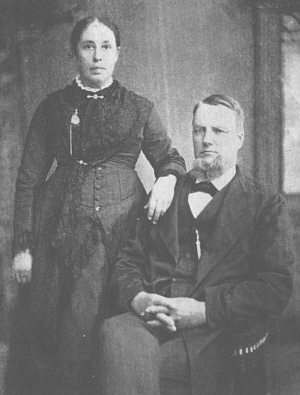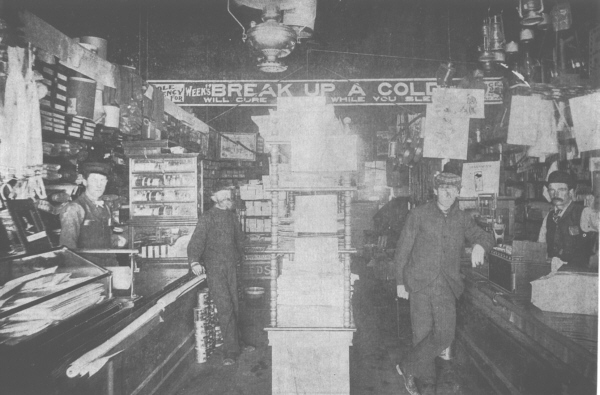The Story of Granton
and
How Maple Works Got its Name
By Mrs. F. E. Winn
From "The Book of The Years", The Clark County Centennial 1853-1953
It is hard for the average person of today to imagine the hardships and problems besetting the pioneers who came into this part of Clark County to establish new homes and to wrest from this wilderness the developed community that we know today.
In the fall of 1855 John D. Wage with his wife and family of four children and his neighbor, Levi Marsh, left comfortable homes in Bradford county, Penn., and started west to build new homes in that part of Clark county that had been formed and named town of Lynn, part of which later became Grant.
They reached Sparta late in the fall and remained there until the spring of 1856 when the trails (not roads) to Neillsville were considered passable. Wage, then 74 years old, had been advised to trade his horses for a yoke of oxen, as oxen were said to be better able to stand the rig- ors of travel through the forests.

Amanda & Nelson Marsh
Nelson Marsh did lots of different things for his pioneer neighbors. He sorted (but did not read) their mail; he mended their shoes; he pulled their teeth with an old style turnkey. Honest and able, he did not need to be a good penman. So when he sent to Washington the name of the new post office, the dull boys down there could not make out his writing. He wrote "Maple Wood" but they thought he wrote "Maple Works." So they gave it that name, and the name stuck.
Oxen Were Better A few miles out of Sparta they came upon the George Williams family, bogged down in the mire. The ox team was hitched on and soon the party was on dry land. Mr. Williams had not heeded the advice about oxen and had kept his horses, but as they were all headed for the same part of the county, they joined forces and the rest of the journey was completed with- out incident, except this:- As they were fording a sizable stream, the Williams hog broke out of its crate and went down the stream, never to be seen again.
This little caravan left Neillsville (then only a few houses) and followed the trail to what is now the Harold Huckstead farm. From there, they drove through the virgin forest to the Wage holding, now the Eugene Theide farm. The men folks all joined in and soon had a log dwelling built to house the women and children. Then the men proceeded to erect similar dwellings for Levi Marsh (now the Walter Trimberger home) and then went on to the Williams land (now the Arno Sternitzky farm). These three families became fast friends and all the work was shared by the men folks.
Large trees were felled and burned so as to clear the land. They planted gardens among the stumps to supply food. They had reached their destination in June 1856.

THE OLD OPELT STORE AT LYNN
This is a typical General Store of the nineteenth and early twentieth century. It was run for 26 years by Max Opelt, who died in 1937 and who is seen at the right behind the counter.
The clerk who helped Max, behind the counter at left, was Anton Hoganson, who was, later postmaster at Chili, now dead. Note that both Max and his clerk are in their shirt sleeves, and both wearing headgear, Max' hat being a low, flat derby.
The light came from the large lamp at top center, which had a round wick and made more heat than light. Lanterns are in evidence at top right.
No cash register, but instead the small cabinet in front of Max, where he kept his, records. He retired from the store and went into farming in 1916; had a cash register the last few years. He granted long-time credit, as much as a year. His son Carl says he lost very little. The solid farmers were accustomed to annual settlements and kept their credit good.
Note the sign at the top rear, indicating that Max handled a few drugs. He also had ribbons in an old-style case. Against this case is standing old Carl Opelt, father of Max and long dead. The fourth person in the picture, standing in front of Max, is not certainly identified. Arthur Opelt, who loaned this picture, believes him to be a member of the Gotter family.
Name of Maple Works
A few years later, Nelson Marsh, a brother of Levi, joined the settlers. His first few years here were devoted to clearing land enough to support a large family. Then he joined the army and served for several months. Just before receiving his discharge he became ill and was hospitalized. He returned home in August 1865, unable to do any more hard labor. So he left the farm work to his sons and devoted his time to the development of the community. He helped establish the post office at Maple Works. The name c h o s e n was Maple Wood, but because of the poor penmanship the powers at Washington deciphered the name as Maple Works and it cap held this name for years. Mr. Marsh became the first postmaster and held that position until the service there was discontinued in 1890. The comfortable farm home was enlarged so as to accommodate the new settlers, land buyers and surveyors coming here after the close of the Civil war.
He Loved to Marry Them
Mr. Marsh served as town chairman for many years and as justice of the peace for 30 years, a job very much to his liking, as he was called upon to officiate at all the weddings. These weddings were big social events, taking place in the homes, to be followed by big dinners and then a dance. Here, too, Mr. Marsh excelled as a fiddler. He fiddled away until the wee hours of the morning, knowing full well that the harder they danced the more shoes he'd have to repair, at his shoe shop in a corner of the post office building. Mrs. Marsh was a very likeable woman and the Marsh home became like a community center.
Another feature of the Marsh home was the addition of a Negro, by the name of Carter Warring, or Warren, who served as a handy man around the place. Being the first colored man in this part of the country, he was a curiosity to most of the settlers.
He Prayed to Be White
This Negro was a deeply religious man. He prayed daily that he might become white. When he last visited here about 1927-28, he was white, a phenomenon which, he claimed, was wrought by prayer.
The Marsh homestead was across the road from that of his brother, Levi, near the Holmes sisters' residence. Maple Works continued to grow as the settlers continued to come here from the Eastern states.
Among the settlers from New York state were six Davis brothers, Damon, Whiston, Sidney, Theodore, Bushrod and Solon. The first two settled in Fremont, Sidney and Theodore in Grant and the other two in York. All these men were hard workers, quickly cleared their land and holdings and started farms.
First Cheese Factory
Sidney was more interested in dairying and he developed a milking strain of native cows and established the first cheese factory in this community. Three lee brothers from the same part towns of York and Grant-now the Granton school district. One brother-in-law, Fred W. Davis, distantly related to the other Davis family, became a cattle buyer and his skill in this type of work was known throughout the community. It was through his efforts that the railroad, being built from Neillsville to Marshfield in 1889-1890, established their depot, named Granton, on its present site. This site was on land owned by Thos. D. Wage, who sold out his land to S. L. Marsh, (son of Nelson Marsh), who platted the village of Granton and became its first postmaster.
Cleared Land Rapidly
Now that t h e r e was transportation handy for the sale of lumber the land was rapidly cleared and the fine roads and farms we see today came into being. The toil and heartaches and privations of those early settlers are almost forgotten today with splendid schools, stores, hospitals, doctors and dentists near at hand and able to cover the distances in a few minutes in high powered cars. We of to- day can hardly realize that when John Wage was, in 1866, critically injured clearing his land, a man on horseback had to ride to Black River Falls to summon a doctor.
(Editor's insert--The biographical history of 1891, published by the Lewis Publishing Co., of Chicago, contains the following about John Wage:- "He came to Wisconsin in 1856 and settled in the town of Grant, then Lynn. He bought 320 acres of land there, paying for it ten shillings per acre. He was killed in 1866, in a logging fallow, by a stick which he was hauling catching in the ground, and striking him on the head. He is buried in Grant township.)
Let us honor and pay tribute to those sturdy men who had the vision and foresight to come to Clark county, especially town of Grant, and make it a splendid place to live.
Contact for this webpage is James W. Sternitzky PhD
Return to Grant Township History Web Page
Return to Grant Township Home Page
**This Clark Co., WI Internet Library, ALHN & AHGP website is dedicated to the free sharing of information by researchers, local historians, genealogists and educators. Because of our non-profit status, submissions are not to be used for profiteering of any kind. Our representatives cannot accept gratuities beyond the basic expenses (i.e. postage, copying, courthouse or rental fees) for obtaining requested information. We reserve the right to ban the involvement of anyone who intentionally disregards these policies. Promotion of research services or publications is not permitted on these pages, or by our representatives without the prior endorsement of the site overseers. If you need professional help, we recommend contacting an accredited genealogist. Please show your appreciation for this database by Becoming a Clark County History Buff or making a contribution to our Support Fund and Perpetual Preservation Account to help keep this Clark Co., WI database freely available on the World Wide Web and free from commercial enterprise.
*** This copyrighted Clark Co., Wis. genealogy and history material is used on this nonprofit site with permission of the submitter. Contact us if you are personally aware of anyone using this submitted data inappropriately. It may not be copied and posted on any commercial genealogy sites such as Family Tree Maker or the merged companies Ancestry.Com/RootsWeb/MyFamily or sold for personal profit.
|
© Every submission is protected by the Digital Millennium Copyright Act of 1998.
Show your appreciation of this freely provided information by not copying it to any other site without our permission.
Become a Clark County History Buff
|
|
A site created and
maintained by the Clark County History Buffs
Webmasters: Leon Konieczny, Tanya Paschke, Janet & Stan Schwarze, James W. Sternitzky,
|
